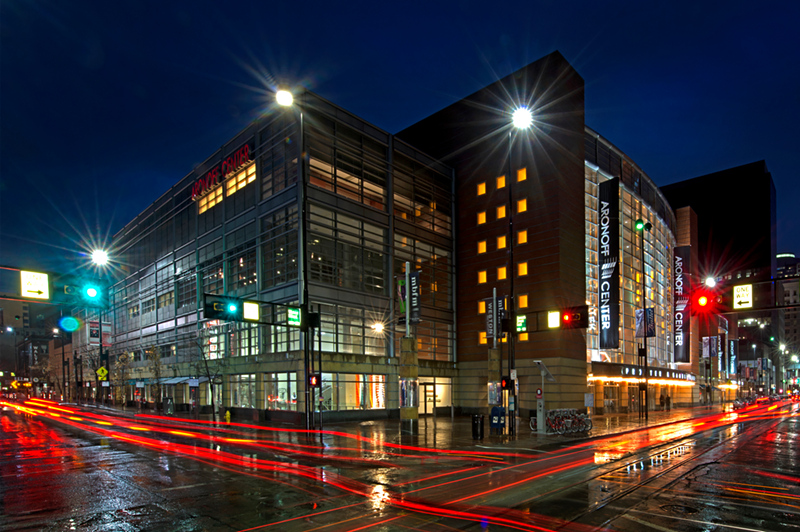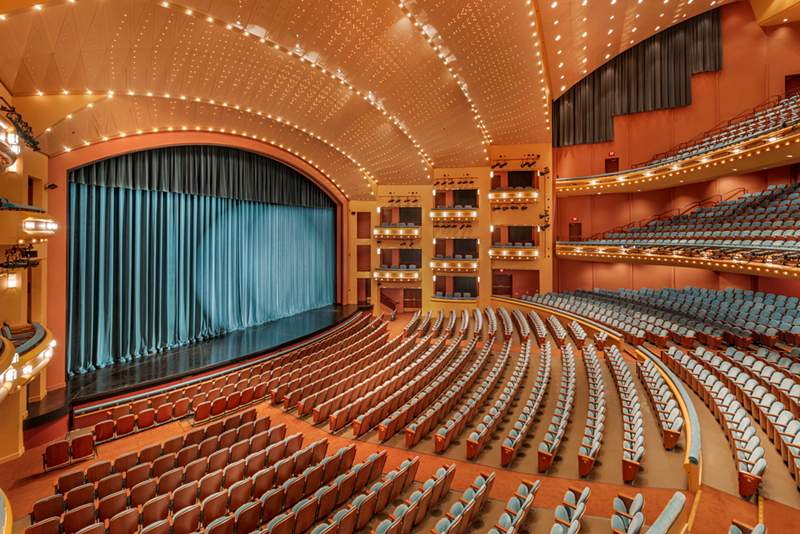The Aronoff Center for the Arts turns 25 this month and although COVID shut down public commemorations, the center’s quarter century shows there’s much to celebrate.
Designed by world-renowned architect César Pelli, the Aronoff Center is home base for the Broadway in Cincinnati series and the Cincinnati Ballet, as well as dozens of local organizations’ stage performances — all held in the Aronoff’s three venues, which accommodate audiences from 2,719 in Procter & Gamble Hall to 437 in the Jarson-Kaplan Theater to 150 in the Fifth Third Bank Theater. The Weston Art Gallery occupies the lower level, making the Aronoff a true arts hub.
Up until the statewide shutdown in mid-March, the Aronoff racked up impressive numbers over its 25 year history: 16,297 performances, attendance for all programs at 10.9 million and an estimated economic impact at a jaw-dropping $450 million. There’s little doubt that downtown Cincinnati’s turnaround took root when the Aronoff’s construction began in 1993 on the corner of Walnut and Seventh streets — despite controversy at the time that the new center would mean the end of OTR’s Music Hall.
The controversy was so overheated that it resulted in a ballot issue aimed at derailing the project proposed to be the heart of a “downtown entertainment district.” At the time, Walnut Street was a run-down home to some small businesses and restaurants, and many scorned the notion that the arts center would spark development.
Funding for the project was secured from the State of Ohio by then-Senate President Stanley Aronoff, a venerable Cincinnati politician. The ballot issue failed, demolition of the Walnut Street block between Sixth and Seventh streets proceeded and construction was underway. Leaders decided the building should be named in Aronoff’s honor, and it opened in October 1995.
“We’re really proud to be a part of a successful downtown, COVID notwithstanding,” says Steve Loftin, president of the Cincinnati Arts Association (CAA), which manages both the Aronoff Center and Music Hall.
The Broadway series may be the building’s best-known occupant but the CAA’s strong advocacy for community engagement was a priority before the concrete was poured, Loftin says. That commitment extends from providing office space for local arts groups to offering rental subsidies to performers and providing a range of programs benefiting thousands of students and adults.
“Early on there was an emphasis to include spaces that were right-sized and hopefully affordable for the local arts producers to use,” he says. “We invited input from those we anticipated would use the building and it was pretty collaborative.”
But the Aronoff’s rental fees are often beyond the means of small groups. The same year the Aronoff opened, the late Bill Friedlander worked with the Greater Cincinnati Foundation to establish the Aronoff Center Rental Subsidy Program, administered by CAA. Grants are awarded in January and provide direct rebates on rental fees. Recipients include Cincinnati Music Theatre, Contemporary Dance Theater and de la Dance Company.
After the Aronoff opened in 1995, the CAA recruited individuals for the Building Diverse Audiences Advisory Committee. Stephen Dobbins was a founding member in 1996 and is now committee chairman, a passionate advocate for community arts initiatives. Dobbins says that the 11 members represent Cincinnati’s ethnic, racial and age demographics and take seriously their roles as CAA representatives promoting the arts throughout the community.
“(BDAAC has) been very effective to help bring programs not only to Cincinnati but also throughout the region,” he says.
He cites the committee’s work with school programs as its proudest accomplishment, inspiring the committee to maintain a network (CAA Connectors) to inform community agencies and organizations about their activities.
Joyce Bonomini, CAA vice president for education and community engagement, calls BDAAC her “conscience” and says the group is genuinely focused on broad inclusion. She adds the committee is a powerful resource for her department’s efforts to respond to the pandemic’s impact on community programs that extend far beyond school field trips.
Bonomini lists Artists in Schools, SchoolTime, Arts in Healing and the Overture Awards as CAA’s flagship programs, with over 100,000 youths and families participating throughout the Greater Cincinnati area.
“Ironically, that’s helped us because we now have parents educating their kids at home and they are desperate for quality product, especially in the arts, that they can share with their kids,” Bonomini says.
With field trips on indefinite hiatus and theaters closed, Bonomini heads a national task force to craft virtual products “as fluid as the decision-making in schools.”
“It’s not just a performance. It’s a Q&A with the artist and classroom resources that can be used for synchronous or asynchronous learning,” she says.
Other programs are re-emerging. Arts in Healing is returning to three hospice locations and to the veterans hospital. The Overture Awards, recognizing outstanding high school performing artists, is being reconfigured.
Bonomini is also working on Conversations Through Art, a series of discussions with well-known BIPOC artists about racism’s impact on their lives and their work. BDAAC brought the idea forward following an emotional meeting with CAA senior staff in the wake of George Floyd’s murder. Although no dates have been announced, Bonomini says the presenters are being confirmed and she hopes to take the program to a national audience.
Although attendance numbers won’t match those of previous years, Bonomini says the number of schools and individuals requesting program content underscores the arts’ role in self-expression and healing. She’s optimistic that funding sources will continue their support.
“I’ve seen how art can heal the world,” she says. “Art is transformative.”
Steve Loftin is equally passionate about the Aronoff’s role in continuing as a force for community engagement and involvement as the arts emerge from the pandemic. Both he and Bonomini agree that technology has taken on an even greater role in communication, production values and program development.
“Virtual performances certainly don’t have the magic of a live performance, but it keeps the interest alive,” Loftin says.
And although artists and audiences are desperate to return, Loftin cautions that live performances “aren’t happening anytime soon.”
“We have to recalibrate our operations processes and build trust with our audiences so that they can make their own decisions on when to attend,” he says.
Loftin says that laying off 46 full-time and over 60 part-time employees was “disheartening and heartbreaking” but he hopes to bring people back as activity picks up.
As for the building itself, Loftin reports it’s in great shape, with work being done on the infrastructure.
What COVID hasn’t affected is pride in the Aronoff Center’s mission.
“We serve everyone,” says Dobbins. “There’s no other place in Cincinnati where you can experience world-class performances as well as local, regional and national artists.”
And, just for emphasis, Loftin adds: “We are the Aronoff Center for the Arts.”
The Aronoff Center for the Arts is located at 650 Walnut St., Downtown. More info: cincinnatiarts.org.



